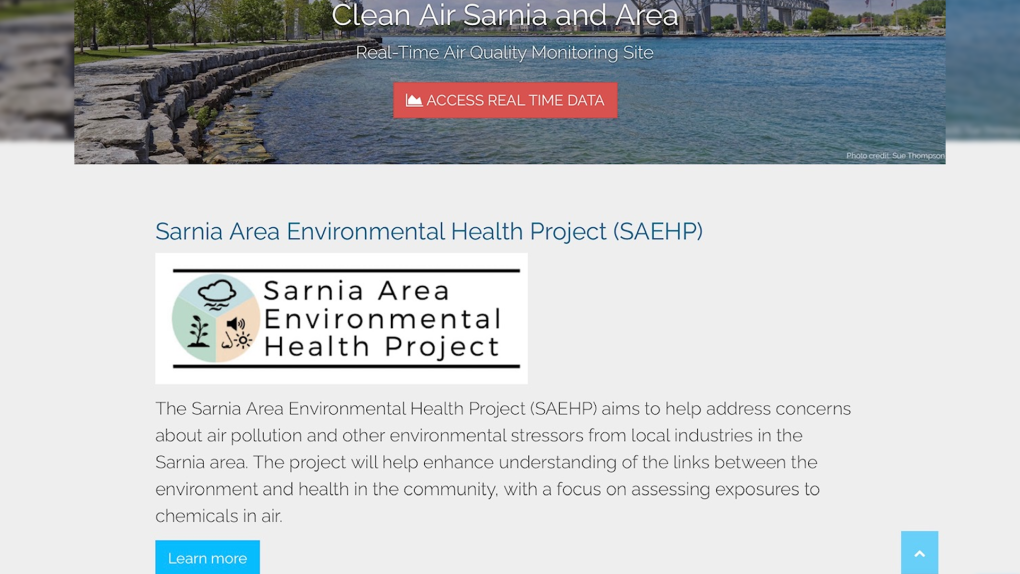'Shut right down until the problem is fixed': Report confirms Chemical Valley air concerns
A newly released report confirms concerning levels of chemicals in the air near Sarnia's Chemical Valley, with the heaviest concentrations on a nearby First Nation territory.
It's what Aamjiwnaang First Nation members have been fearing for decades; the air they breathe could be killing them.
Aamjiwnaang environmental activist Ada Lockridge told CTV News on Thursday that it has to stop, "Shut right down until the problem is fixed. That's what they should be doing, and quit adding to the mixture in the air until they know what's going on."
Lockridge was on hand as results of the Sarnia Area Environmental Health Project were released by the Ministry of the Environment officials.
It included an analysis that found concerning levels of benzene on the northern edge of Aamjiwnaang and in south Sarnia. Both sit adjacent to Chemical Valley industries.
Glenn Ferguson was part of the presentation, which was also streamed online, "In certain parts of the study area we observed that were would be an elevated airborne concentrations of benzene that can result in an increased risk of blood cancer, specifically leukemia, that's above acceptable levels."
Ferguson is an environmental health scientist with the firm Intrinsik, one of three consulting firms that worked with area First Nations, the Ministry of the Environment, and Lambton Public Health, among others.
He said the Ontario benchmark for identifying benzene risk is one additional incidence of cancer per one million people, "We are above that level and in some cases. Specifically in those areas we identified, significantly above."
 A new report confirms levels of benzene that could lead to increased cases of blood cancers, including leukaemia. (Source: cleanairsarniaandarea.com)
A new report confirms levels of benzene that could lead to increased cases of blood cancers, including leukaemia. (Source: cleanairsarniaandarea.com)
Thirty-seven other chemicals used in local industries were identified for having potential risk, but only one other concerning emission was highlighted, sulfur dioxide.
Sulfur dioxide emissions are mostly linked to what is called flaring, burning off excess flammable gases. Ministry officials say large releases can also occur during power outages.
Sulfur dioxide releases are of most concern to those with asthma or other respiratory illnesses.
Lockridge feels the analysis doesn’t fully address the cumulative effects of various chemicals in the air, "There's a whole lot of other chemicals out there floating around and once they mix together, what is it? And what harm is that going to do to you now?"
Environment Ministry officials believe this report will be a trigger for regulatory and enforcement improvement.
Rachel Melzer is the human toxicology team lead for the Ministry of the Environment, "We're bringing that information back to the ministry to take action on; and you, likely, will hold the ministry’s feet to the fire, too."
The data analyzed covered a period from 2015 to 2019. It included advanced modelling by industry experts, analysis of air quality monitoring stations throughout the region and industry reporting on chemicals used.
Melzer told the meeting that high levels of benzene continue to enter the air, with one of the largest releases on record happening earlier this year.
CTVNews.ca Top Stories

Much of Canada is under an extreme weather alert this weekend: here's what to know
From snow, to high winds, to extreme cold, much of Canada is under a severe weather alert this weekend. Here's what to expect in your region.
Calgary woman stranded in Mexico after husband's death during diving trip
A Calgary woman is struggling to return home after her husband died while diving in Mexico, leaving her stranded and facing financial hardship.
Fugitive U.S. rioter seeks asylum in Whistler amid warnings of more to come
An American citizen convicted of participating in the Jan. 6, 2021, riot on Capitol Hill and dodging jail time in Whistler may just be the start of an asylum-seeking rush, according to a prominent legal expert.
'I gave them a call, they didn't pick up': Canadian furniture store appears to have gone out of business
Canadian furniture company Wazo Furniture, which has locations in Toronto and Montreal, appears to have gone out of business. CTV News Toronto has been hearing from customers who were shocked to find out after paying in advance for orders over the past few months.
Thirty years on, is Quebec headed for another independence referendum?
On the eve of the 30th anniversary of Quebec's second independence referendum -- the first one was in 1980 -- it seems the tide could be turning again. Legault is deeply unpopular after six years in power, and the Parti Quebecois, with a young, charismatic leader, has been ahead in the polls for more than a year.
Soldier who died by suicide in Las Vegas told ex-girlfriend of pain and exhaustion after Afghanistan
The highly decorated Special Forces soldier who died by suicide in a Cybertruck explosion on New Year's Day confided to a former girlfriend who had served as an Army nurse that he faced significant pain and exhaustion that she says were key symptoms of traumatic brain injury.
Man arrested after committing five bank robberies in 10 days: Toronto police
A man accused of robbing five Toronto-area banks in a 10-day period has been arrested by Toronto police.
Four puppies abandoned in northern Ont. rescued, rehomed
On New Year's Day, a pair had gone for a drive on northern Ontario backroads near Markstay-Warren to look at the local wildlife when they came upon four puppies in the middle of the road in the cold.
Special national Liberal caucus meeting called for next week after regional chairs meet: sources
A special meeting of Prime Minister Justin Trudeau's national Liberal caucus has been called for next Wednesday, sources say.


































